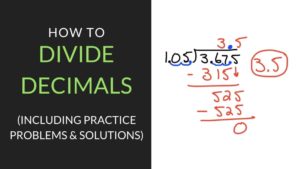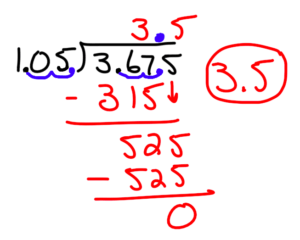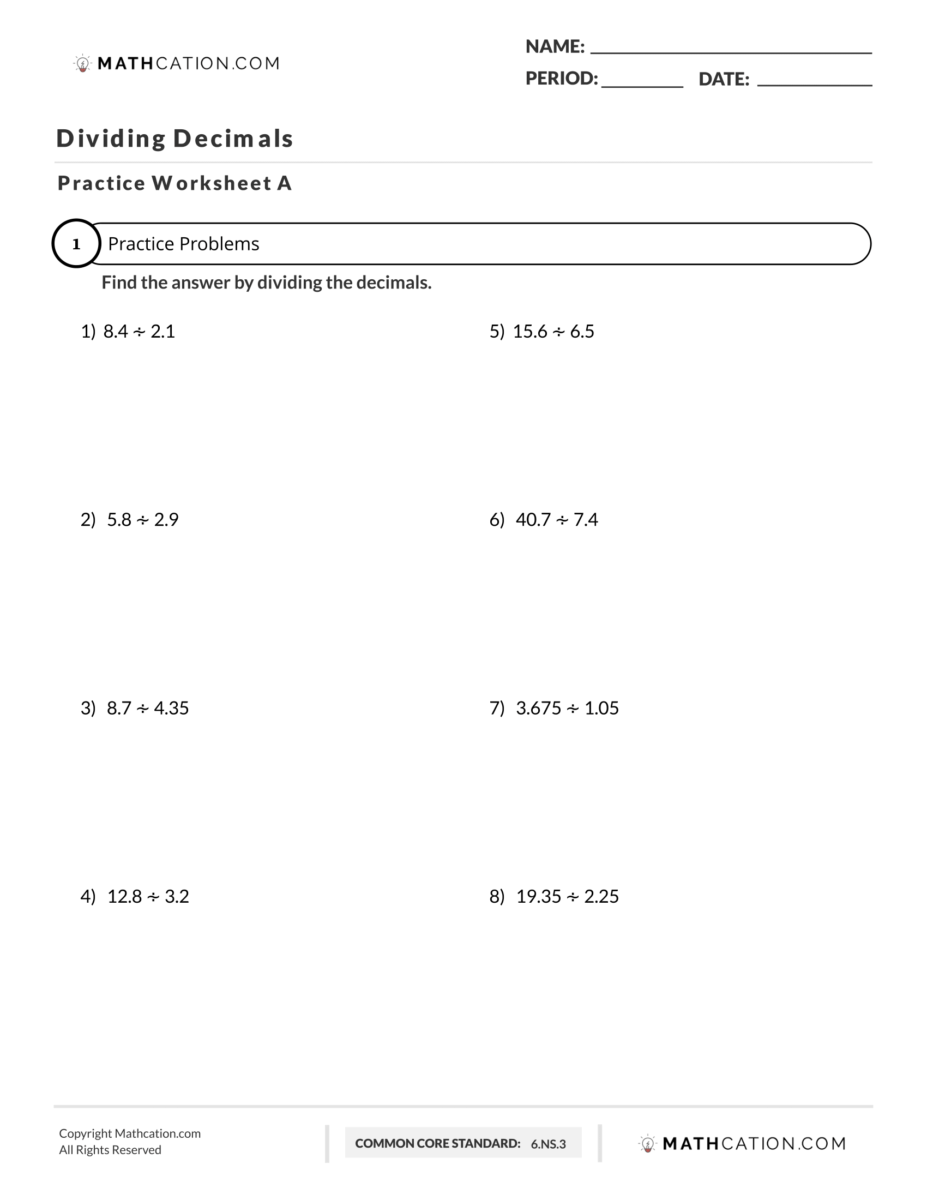How to Divide Decimals Worksheet, Examples, and Definition
Get the free Dividing Decimals worksheet and other resources for teaching & understanding how to Divide Decimals
Key Points about how to Divide Decimals
- Dividing decimals is an essential math skill that is used in everyday life.
- To divide decimals, individuals should first understand how to convert fractions to decimals, how to round decimals, and how to use place values.
- Dividing decimals can be done in different ways, such as dividing decimals by whole numbers, dividing decimals by decimals, and rewriting fractions as decimals.
Dividing Decimals: Simple Steps to Follow
Dividing decimals is an essential math skill that is used in everyday life. It involves splitting decimal numbers into smaller parts to determine the quotient. Understanding decimals division is crucial because it helps individuals to solve real-world problems, such as calculating the cost of items, determining the length of time, and measuring the distance between two points.
To divide decimals, individuals should first understand how to convert fractions to decimals, how to round decimals, and how to use place values. Once they have a solid foundation in these areas, they can then learn how to divide decimals step by step. The process involves dividing the dividend by the divisor, placing the decimal point in the correct position, and bringing down zeros if necessary.
Dividing decimals can be done in different ways, such as dividing decimals by whole numbers, dividing decimals by decimals, and rewriting fractions as decimals. Rounding decimals is also an important skill to have when dividing decimals. With practice, individuals can master dividing decimals and use it to solve complex problems.
Dividing Decimals is the process of dividing two numbers that are decimals with each other. When Dividing Decimals together you must move the decimal in the divisor to the right so that it becomes a whole number. Next, you move the decimal in the dividend the same amount of times that you moved the decimal in the divisor. Divide the numbers normally as if they were not decimals to start with. The last step for finding How to Divide with Decimals is to place the decimal point in your answer. In order to do this you must move the decimal straight up from your dividend into your answer.
Common Core Standard: 6.NS.3
Related Topics: Adding Decimals, Subtracting Decimals, Multiplying Decimals, Greatest Common Factor, Least Common Multiple
Return To: Home, 6th Grade

The Key to Understanding Decimals Division
What are Decimals?
Decimals are a way of expressing numbers that are not whole. They are used to represent parts of a whole number, such as tenths, hundredths, and thousandths. Decimals are written using a decimal point, which separates the whole number from the decimal part. For example, the number 3.14 is a decimal number, with 3 as the whole number and 0.14 as the decimal part.
How to Read Decimals
Reading decimals is simple once you understand the basics. The whole number part of a decimal is read as you would normally read a whole number. The decimal part is read as a fraction, with the denominator based on the number of decimal places. For example, the decimal 0.25 would be read as “twenty-five hundredths” because it has two decimal places.
Dividing Decimals by Decimals
Dividing decimals is similar to dividing whole numbers, but with a few extra steps. The key is to align the decimal point of the divisor and dividend, and then move the decimal point of the divisor to the right until it becomes a whole number. Then, move the decimal point of the dividend the same number of places to the right. Perform the division as usual, and then move the decimal point of the quotient the same number of places to the left as you moved the decimal point of the divisor.
For example, to divide 4.8 by 0.2, you would first move the decimal point of the divisor one place to the right, making it 2. Then, move the decimal point of the dividend one place to the right, making it 48. Perform the division, which gives you a quotient of 24. Finally, move the decimal point of the quotient one place to the left, giving you a final answer of 24.
In conclusion, understanding decimals is essential to dividing decimals. Decimals are a way of representing numbers that are not whole, and they are written using a decimal point. To read decimals, you need to read the whole number part and the decimal part as a fraction. Dividing decimals involves a few extra steps, but it is similar to dividing whole numbers.
Dividing Decimals Examples
Dividing decimals can be a bit tricky, but with practice, it can become easier. Here are some examples to help you understand the process better:
Example 1: Dividing a Decimal by a Whole Number
Let’s divide 3.6 by 2.
| 2 | ||
|---|---|---|
| 3.6 |
First, we move the decimal point in 3.6 one place to the right to get 36. Then, we divide 36 by 2, which gives us 18. Therefore, 3.6 ÷ 2 = 1.8.
Example 2: Dividing a Decimal by a Decimal
Let’s divide 5.4 by 0.3.
| 0.3 | ||
|---|---|---|
| 5.4 |
We need to move the decimal point in 0.3 one place to the right to get 3. Then, we move the decimal point in 5.4 one place to the right to get 54. Now, we divide 54 by 3, which gives us 18. Therefore, 5.4 ÷ 0.3 = 18.
Example 3: Dividing a Decimal by a Larger Decimal
Let’s divide 0.6 by 0.8.
| 0.8 | ||
|---|---|---|
| 0.6 |
We need to add a zero to the right of 0.6 to make it 0.60. Then, we move the decimal point in 0.8 one place to the right to get 8. Now, we divide 60 by 8, which gives us 7.5. Therefore, 0.6 ÷ 0.8 = 0.75.
Practice Questions
Here are some practice questions to help you master dividing decimals:
- 4.2 ÷ 0.6 =
- 0.45 ÷ 0.05 =
- 9.6 ÷ 2.4 =
- 0.75 ÷ 0.25 =
- 3.6 ÷ 0.4 =
Remember to move the decimal point to the right in the divisor to make it a whole number, and then move the decimal point in the dividend the same number of places to the right. Then, divide as you would with whole numbers. With practice, you’ll be dividing decimals like a pro in no time!
How to Divide Decimals Step By Step
Dividing decimals can be tricky, but with a few simple steps, it can be easily done. In this section, we will discuss how to divide decimals step by step.
How to Divide Two Decimals
To divide two decimals, follow these steps:
- Write the divisor (the number you are dividing by) and the dividend (the number you are dividing) as decimals.
- Move the decimal point in the divisor to the right until it becomes a whole number.
- Move the decimal point in the dividend the same number of places to the right as you did in the divisor.
- Divide the new dividend by the whole number divisor.
- Write the quotient (the answer) as a decimal.
For example, let’s divide 6.8 by 0.4:
- Divisor: 0.4, Dividend: 6.8
- Move the decimal point in the divisor one place to the right: 0.4 becomes 4.
- Move the decimal point in the dividend one place to the right: 6.8 becomes 68.
- Divide 68 by 4: 68 ÷ 4 = 17.
- Write the quotient as a decimal: 17.
Therefore, 6.8 ÷ 0.4 = 17.
How to Divide Two Decimals with Remainders
To divide two decimals with remainders, follow these steps:
- Write the divisor and dividend as decimals.
- Move the decimal point in the divisor to the right until it becomes a whole number.
- Move the decimal point in the dividend the same number of places to the right as you did in the divisor.
- Divide the new dividend by the whole number divisor.
- Write the quotient as a whole number with a remainder.
- Move the decimal point in the remainder to the right one place and add a zero to the end.
- Divide the new number by the divisor.
- Write the quotient as a decimal.
For example, let’s divide 5.2 by 2.3:
- Divisor: 2.3, Dividend: 5.2
- Move the decimal point in the divisor one place to the right: 2.3 becomes 23.
- Move the decimal point in the dividend one place to the right: 5.2 becomes 52.
- Divide 52 by 23: 52 ÷ 23 = 2 with a remainder of 6.
- Write the quotient as a whole number with a remainder: 2 R6.
- Move the decimal point in the remainder one place to the right and add a zero: 60.
- Divide 60 by 23: 60 ÷ 23 = 2 with a remainder of 14.
- Write the quotient as a decimal: 2.2.
Therefore, 5.2 ÷ 2.3 = 2.2 with a remainder of 14.
Dividing Decimals by Whole Numbers
When dividing decimals by whole numbers, the process is similar to dividing whole numbers. The only difference is that you need to consider the decimal point. Here are the steps to divide decimals by whole numbers:
Steps to Divide Decimals by Whole Numbers
- Write the decimal and the whole number in a division equation.
- Move the decimal point of the dividend (the number being divided) to the right until it becomes a whole number. Keep track of how many times you moved the decimal point.
- Move the decimal point of the divisor (the number doing the dividing) the same number of places to the right as the decimal point in the dividend.
- Divide the whole number that you obtained in step 2 by the whole number in step 3.
- Write the quotient with the same number of decimal places as the dividend.
Example Problems
Example 1:
Divide 4.2 by 3.
- Write the equation:
4.2 ÷ 3 - Move the decimal point of 4.2 one place to the right to make it 42.
- Move the decimal point of 3 one place to the right to make it 30.
- Divide 42 by 30 to get 1.4.
- Write the quotient with the same number of decimal places as the dividend:
1.4
Example 2:
Divide 8.7 by 6.
- Write the equation:
8.7 ÷ 6 - Move the decimal point of 8.7 one place to the right to make it 87.
- Move the decimal point of 6 one place to the right to make it 60.
- Divide 87 by 60 to get 1.45.
- Write the quotient with the same number of decimal places as the dividend:
1.45
Dividing decimals by whole numbers can be a bit tricky, but following these steps can make it much easier. With practice, you can become proficient at dividing decimals by whole numbers.
Dividing Decimals by Decimals
Dividing decimals by decimals is an important skill in mathematics. It is a fundamental operation that is used in many real-life situations, such as calculating the cost per unit of a product or finding the average of a set of numbers. In this section, we will discuss the steps to divide decimals by decimals and provide example problems.
Steps to Divide Decimals by Decimals
To divide decimals by decimals, follow these steps:
- Move the decimal point in the divisor (the number you are dividing by) to the right until it becomes a whole number.
- Move the decimal point in the dividend (the number you are dividing) the same number of places to the right.
- Divide the numbers as you would with whole numbers.
- Count the number of decimal places in the dividend and the divisor.
- Place the decimal point in the quotient (the answer) so that it has the same number of decimal places as the sum of the decimal places in the dividend and the divisor.
For example, to divide 3.6 by 0.6, we can follow these steps:
- Move the decimal point in 0.6 one place to the right to get 6.
- Move the decimal point in 3.6 one place to the right to get 36.
- Divide 36 by 6 to get 6.
- The dividend has one decimal place and the divisor has one decimal place, so the quotient should have one decimal place.
- Place the decimal point in the quotient after the 6 to get 6.0.
Example Problems
Here are some example problems to help you practice dividing decimals by decimals:
- Divide 4.2 by 0.3.Solution:
- Move the decimal point in 0.3 one place to the right to get 3.
- Move the decimal point in 4.2 one place to the right to get 42.
- Divide 42 by 3 to get 14.
- The dividend has one decimal place and the divisor has one decimal place, so the quotient should have one decimal place.
- Place the decimal point in the quotient after the 4 to get 14.0.
Answer: 14.0
- Divide 0.8 by 0.04.Solution:
- Move the decimal point in 0.04 two places to the right to get 4.
- Move the decimal point in 0.8 two places to the right to get 80.
- Divide 80 by 4 to get 20.
- The dividend has two decimal places and the divisor has two decimal places, so the quotient should have four decimal places.
- Place the decimal point in the quotient after the 20 to get 20.00.
Answer: 20.00
Dividing decimals by decimals can be a bit tricky at first, but with practice and a good understanding of the steps involved, you can master this important skill. You can also use a calculator to check your work or to perform more complex calculations.
5 Quick Dividing Decimals Practice Problems
Rewriting Fractions as Decimals
When working with decimals, it is important to understand how to rewrite fractions as decimals. This skill is especially useful when working with real-world problems that involve money or measurements.
Equivalent Fractions as Decimals
Before diving into the steps to rewrite fractions as decimals, it is important to understand the concept of equivalent fractions. Equivalent fractions are fractions that represent the same value, but are written with different numbers. For example, 1/2 and 2/4 are equivalent fractions because they both represent half of a whole.
To rewrite an equivalent fraction as a decimal, simply divide the numerator (top number) by the denominator (bottom number). For example, to rewrite 1/2 as a decimal, divide 1 by 2 to get 0.5.
Steps to Rewrite Fractions as Decimals
When rewriting fractions as decimals, follow these steps:
- Divide the numerator (top number) by the denominator (bottom number).
- If the denominator is not a power of 10 (such as 10, 100, or 1000), move the decimal point to the right until the denominator is a power of 10. For example, to rewrite 1/4 as a decimal, divide 1 by 4 to get 0.25. Since 4 is not a power of 10, move the decimal point one place to the right to get 0.25.
- If the fraction does not simplify to a terminating decimal (a decimal that ends), continue dividing until the pattern repeats. For example, to rewrite 1/3 as a decimal, divide 1 by 3 to get 0.3333… The pattern repeats, so the decimal can be written as 0.3̅.
It’s important to note that when working with repeating decimals, the repeating pattern should be indicated with a bar over the repeating digits. For example, 0.3̅ represents the repeating decimal 0.3333….
By understanding how to rewrite fractions as decimals, individuals can work with decimal numbers more easily and accurately.
Rounding Decimals
When dividing decimals, it is often necessary to round the answer to a certain number of decimal places. Rounding decimals is a crucial skill to have when working with numbers that require a high level of accuracy.
Rules for Rounding Decimals
The rules for rounding decimals are similar to those for rounding whole numbers. To round a decimal, you must first determine the place value to which you want to round. For example, if you want to round to the nearest hundredth, you would look at the digit in the thousandth’s place.
If the digit in the place value you are rounding to is 5 or greater, you round up. If it is less than 5, you round down. If the digit in the place value you are rounding to is exactly 5, you round up if the digit to the right of it is odd and round down if it is even.
Examples of Rounding Decimals
Suppose you want to round the decimal 3.456 to the nearest hundredth. The digit in the thousandth’s place is 5, so you must round up. The answer is 3.46.
Now suppose you want to round the decimal 2.344 to the nearest tenth. The digit in the hundredth’s place is 4, which is less than 5, so you must round down. The answer is 2.3.
Another example is rounding the decimal 6.789 to the nearest whole number. The digit in the ones place is 9, so you must round up. The answer is 7.
In conclusion, rounding decimals is a simple process that requires an understanding of place value and basic arithmetic skills. By following the rules for rounding, you can ensure that your answers are accurate and precise.
FAQ about how to Divide Decimals
What are some examples of dividing decimals with answers?
Dividing decimals involves dividing a decimal number by another decimal number. For example, 4.2 ÷ 0.3 = 14. Here, 4.2 is divided by 0.3, which gives us a quotient of 14. Other examples of dividing decimals include 5.6 ÷ 0.4 = 14 and 6.9 ÷ 0.5 = 13.8.
How do you perform long division with decimals?
Long division with decimals is similar to long division with whole numbers. The only difference is that you need to place the decimal point in the correct position. To perform long division with decimals, you first need to place the decimal point in the dividend and divisor. Then, you proceed with the division as you would with whole numbers. For example, 8.4 ÷ 0.6 can be solved using long division as follows:
14
___________
0.6| 8.4
7.8
---
0.6
0.0
Therefore, 8.4 ÷ 0.6 = 14.
What is the process for dividing decimals step by step?
The process for dividing decimals step by step is as follows:
- Write the dividend and divisor in long division format, with the decimal point lined up.
- If the divisor is not a whole number, move the decimal point to the right until it becomes a whole number.
- Move the decimal point in the dividend the same number of places to the right as you did with the divisor.
- Divide the new dividend by the whole number divisor.
- Place the decimal point in the quotient directly above where it is in the dividend.
- If there is a remainder, add a decimal point to the quotient and bring down the next digit from the dividend to continue dividing.
Can you divide decimals without using a calculator?
Yes, you can divide decimals without using a calculator. You can use long division to divide decimals by hand. The process is the same as dividing whole numbers, but you need to pay attention to the decimal point placement.
How do you divide decimals by whole numbers in 5th grade?
To divide decimals by whole numbers in 5th grade, you need to follow the same process as dividing whole numbers. First, divide the whole number by the whole number divisor. Then, place the decimal point in the quotient directly above where it is in the dividend. Finally, if there is a remainder, add a decimal point to the quotient and bring down the next digit from the dividend to continue dividing.
What are some dividing decimals examples?
Some examples of dividing decimals include:
- 3.6 ÷ 0.2 = 18
- 7.5 ÷ 0.5 = 15
- 6.4 ÷ 0.8 = 8
- 9.3 ÷ 0.3 = 31
These examples show how to divide a decimal number by another decimal number to get a quotient.
Dividing Decimals Worksheet Video Explanation
Watch our free video on how to Divide Decimals. This video shows how to solve problems that are on our free Dividing Decimals worksheet that you can get by submitting your email above.
Watch the free Dividing Decimals video on YouTube here: How to Divide Decimals Video
Video Transcript:
This video is about how to do long division with decimals. You can get the decimal division worksheet used in this video for free by clicking on the link in the description below. The process for dividing decimals is very similar to the process for dividing regular integer numbers except you have to account for the decimal point by moving the decimal point before you divide.
If we wanted to divide 15.6 divided by 6.5 you would set it up just as you normally would for long division. We’re going to say 6.5 is being divided into 15.6. In order to divide decimals your divisor has to be a whole number. In order to change that you’re going to have to move the decimal point one time to the right. We move it to the right to make it 65. Every time you move the decimal to your divisor you also have to move it to your dividend. we also have to move this decimal point to the right one time. Now that we have decimal points that have been moved you can take your decimal point and your dividend and move it straight up to where your answer where your quotient’s going to go. This decimal point will be where your decimal is located in your solution to the problem. Now we can divide just as we normally would 156 divided by 65. Well, the largest amount of 65s that can go into 156 is 2. It can go in 2 times 65 times 2 is 130 then we’re going to subtract 6 minus 0 is 6 5 minus 3 is 2 and then 1 minus 1 is 0. We’re left with 26. Then we’re going to bring down a 0. This is going to we’re going to have a 0 here. We’re going to bring it down make it 260. Then you have to figure out how many times 65 goes into 260. It goes in four times. Now we have a four here it happens to be 260 and then when you subtract 260 minus 260 you get 0 or no remainder. Your solution will be your quotient up here which is 2.4. That’s going to be the solution to 15.6 divided by 6.5. Let’s do a couple practice problems on our dividing decimals worksheet.
The first problem we’re going to complete on our dividing decimals worksheet is number one. This problem gives us 8.4 divided by 2.1. We’re going to go ahead and set up our division problem. We have 2.1 divided into 8.4. Now remember the divisor has to be a whole number so we’re going to move the decimal point to the right to make a whole number. Now it’s 21 and then if you move the decimal to the right one time to your divisor you also have to do it to your dividend. Our dividend is going to be 84. Now that we have a whole number here, we’re going to take our decimal point and move it straight up into the area of our solution or our quotient’s going to go. You’re just going to divide 21 into 84 which happens to go four times. You say four times here and then 21 times four is 84 and then when you subtract those you will get no remainder or zero. Our solution is going to be four, it would be 4.0 or just four.
The next problem we’re going to complete on our dividing decimals worksheet is number six. This division of decimals problem gives us 40.7 divided by 7.4. We’re going to go ahead and set up our division problem. We’re going to take our decimal point and our 7.4 we’re going to make it a whole number. We move it to the right so now it’s 74 and then you’re going to move your decimal now that you have a whole number for your divisor. You can move the decimal point directly up into where your quotient is going to go then we can go ahead and complete the division. 74 goes into 407 5 times 74 times 5 is 370 then we’re going to subtract 7 minus 0 is 7. 0 minus 7 you can’t do. You have to borrow from the 4 make it a 3 and then turn the 0 into a 10. 10 minus 7 is 3 and then 3 minus 3 just cancels you’re left with nothing. Now we have our zero we’re going to bring down this is going to become 370. And then 74 goes to 370 five times which is also 370 and then when you subtract you will get zero. The solution to this dividing decimals example is 5.5.
The last problem we’re going to complete on our dividing decimals worksheet is number seven. This problem gives us 3.675 divided by 1.05. Again, we’re going to take our decimal point in our divisor and we’re going to move it until we have a whole number. In this case we have to move it two times. We move it two times and the divisor, we also have to move it twice in the dividend. It moves two times in the dividend. Now that we have a whole number, we can move our decimal point directly into the area where our quotient is going to go then we’re going to divide 105 into 367. It goes three times 105 times 3 is 315 then we’re going to subtract 7 minus 5 is 2 6 minus 1 is five and then three minus three is zero or it goes away bring the five straight down. This is going to be a five here and then 105 goes into 525 five times which is also 525 and then when you subtract those you have no remainder or just 0. Our solution to this dividing decimals example is 3.5. Hopefully this video was helpful for teaching you how to divide decimals. Try the other practice problems by downloading the division with decimals worksheets above.
Free Dividing Decimals worksheet Download
Enter your email to download the free Dividing Decimals worksheet
Practice makes Perfect.
We have hundreds of math worksheets for you to master.
Share This Page




